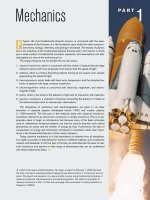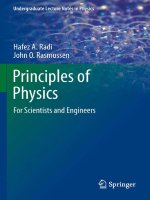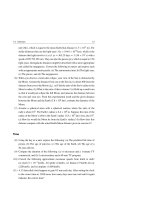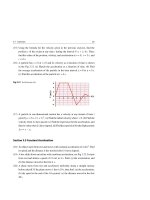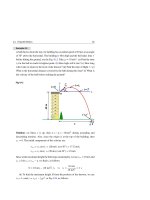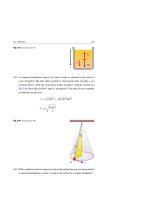Physics for scientists
Bạn đang xem bản rút gọn của tài liệu. Xem và tải ngay bản đầy đủ của tài liệu tại đây (1.5 MB, 30 trang )
Chapter 1
Physics for Scientists &
Engineers, with Modern
Physics, 4th edition
Giancoli
Chapter 1
Introduction, Measurement,
Estimating
Units of Chapter 1
• The Nature of Science
• Models, Theories, & Laws
• Measurement & Uncertainty; Significant Figures
(reviewed in lab)
• Units, Standards, & the SI System
• Converting Units
• Order of Magnitude: Rapid Estimating
• Dimensions and Dimensional Analysis
The Scientific Method
• Feynman: How not to be fooled….
• Observing
– Trends, Patterns, Singular Events
• Asking Questions
– What? When? Where? How? … and WHY?
– Researching prior explanations & models
• Developing Testable Hypothesis
The Scientific Method
• Creating Experiments to TEST Hypothesis
– There is always uncertainty in every
measurement, in every result.
– Building a model *is* an experiment.
• Analyzing results
– Anticipate sources of error
– Refine or Discard Hypothesis
– Develop further tests & Repeat!
– Compare results w/ existing theories
The Scientific Method
• Sharing preliminary results
– Submit a paper to peer-reviewed journal
– Ask colleagues for input
– Present at conferences
– Discuss, Debate, Defend results
• Seeking independent confirmation
• Revising Theories
• Publishing
1-1 The Nature of Science
•Observation: important first step toward
scientific theory; requires imagination to tell
what is important
•Theories: created to explain observations;
will make predictions
•Further Observations will tell if the prediction
is accurate, and the cycle goes on.
•No theory can be absolutely verified,
although a theory can be proven false.
1-1 The Nature of Science
•How does a new theory get accepted?
• Predictions agree better with data
• Explains a greater range of phenomena
•Example: Aristotle believed that objects
would return to a state of rest once put in
motion.
•Galileo realized that an object put in motion
would stay in motion until some force
stopped it.
1-1 The Nature of Science
The principles of physics are used in many
practical applications, including construction.
Communication between architects and
engineers is essential if disaster is to be
avoided.
1-2 Models, Theories, and Laws
•Models: useful to help understand phenomena.
• creates mental pictures, but must be careful
to also understand limits of model
•not take it too seriously
•Example: model bay bridge turnbuckle to
estimate whether it can withstand load…
•A theory is detailed; gives testable predictions.
•Example: Theory of Damped Harmonic
Oscillators
1-2 Models, Theories, and Laws
•A law is a brief description of how nature
behaves in a broad set of circumstances.
•
Ex: Hooke’s Law for simple harmonic
oscillators
•A principle is similar to a law, but applies to a
narrower range of phenomena.
•Ex: Principle of Hydrostatic Equilibrium
1-3 Measurement and Uncertainty;
Significant Figures
No measurement is exact; there is always
some uncertainty due to limited instrument
accuracy and difficulty reading results.
The photograph to the
left illustrates this – it
would be difficult to
measure the width of
this board more
accurately than ± 1 mm.
1-3 Measurement and Uncertainty;
Significant Figures
•Estimated uncertainty written “ ± ”
ex. 8.8 ± 0.1 cm.
•Percent uncertainty: ratio of uncertainty to
measured value, multiplied by 100:
1-3 Measurement and Uncertainty;
Significant Figures
Number of significant figures = number of “reliably
known digits” in a number.
•
Often possible to tell # of significant figures
by the way the number is written:
•
23.21 cm = four significant figures.
•
0.062 cm = two significant figures
(initial zeroes don’t count).
•
80 km is ambiguous—it could have one or
two sig figs. If it has three, it should be
written
80.0 km.
1-3 Measurement and Uncertainty;
Significant Figures
•When multiplying or dividing numbers, or
using functions, result has as many sig figs as
term with fewest.
•ex: 11.3 cm x 6.8 cm = 77 cm.
•When adding or subtracting, answer is no
more precise than least precise number used.
•
ex: 1.213 + 2 = 3, not 3.213!
1-3 Measurement and Uncertainty;
Significant Figures
•Calculators will not give right # of sig
figs; usually give too many but
sometimes give too few (especially if
there are trailing zeroes after a
decimal point).
•top image: result of 2.0/3.0.
•bottom image: result of 2.5 x 3.2.
1-3 Measurement and Uncertainty;
Significant Figures
Conceptual Example 1-1: Significant figures.
Using a protractor, you measure an angle to be
30°. (a) How many significant figures should you
quote in this measurement? (b) Use a calculator to
find the cosine of the angle you measured.
1-3 Measurement and Uncertainty;
Significant Figures
Scientific notation is commonly used in
physics; it allows the number of significant
figures to be clearly shown.
For example, we cannot tell how many
significant figures the number 36,900 has.
However, if we write 3.69 x 104, we know it has
three; if we write 3.690 x 104, it has four.
Much of physics involves approximations;
these can affect the precision of a
measurement also.
1-3 Accuracy vs. Precision
Accuracy is how close a measurement comes
to the true value.
ex. Acceleration of Earth’s gravity = 9.81 m/sec2
Your experiment produces 10 ± 1m/sec2
You were accurate, but not super “precise”
Precision is the repeatability of the
measurement using the same instrument.
ex. Your experiment produces 8.334 m/sec2
You were precise, but not very accurate!
1-5 Converting Units
Unit conversions involve a conversion factor.
Example:
1 in. = 2.54 cm.
Equivalent to:
1 = 2.54 cm/in.
Measured length = 21.5 inches, converted to
centimeters?
How many sig figs are appropriate here?
1-5 Converting Units
Example 1-2: The 8000-m peaks.
The 14 tallest peaks in the world are referred to as “eightthousanders,” meaning their summits are over 8000 m
above sea level.
What is the elevation, in feet, of an elevation of
8000 m?
1-5 Converting Units
•
•
•
•
•
1 m = 3.281 feet
8000 m = 2.6248 E04 or 26,248 feet.
“8000 m” has only 1 significant digit!
Round the answer up to 30,000 ft!
Rather rough!
• 30,000 – 26,248 = 3,752
• 3,752/26,248 = 14.3% high!
1-6 Order of Magnitude: Rapid Estimating
Quick way to estimate calculated quantity:
- round off all numbers to one significant
figure and then calculate.
- result should be right order of magnitude;
expressed by rounding off to nearest power of 10.
1-6 Order of Magnitude: Rapid Estimating
Example 1-5: Volume of a lake.
Estimate how much
water there is in a
particular lake, which is
roughly circular, about 1
km across, and you
guess it has an average
depth of about 10 m.
1-6 Order of Magnitude: Rapid Estimating
Example 1-6: Thickness of a page.
Estimate the thickness
of a page of your
textbook. (Hint: you
don’t need one of
these!)
